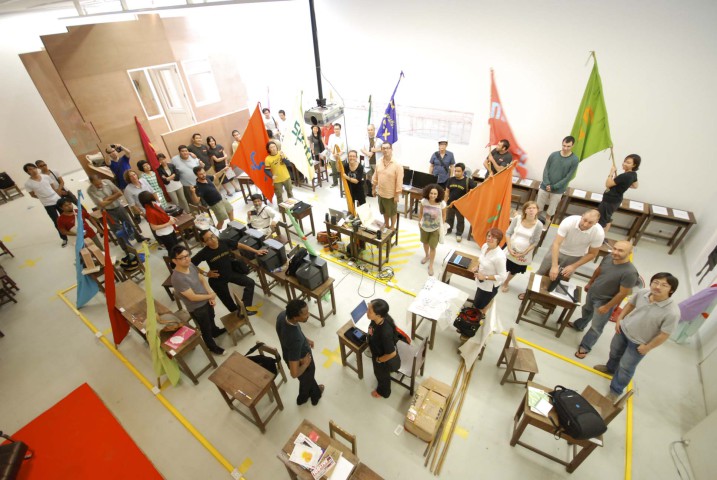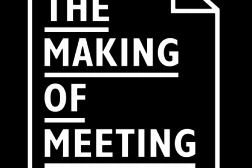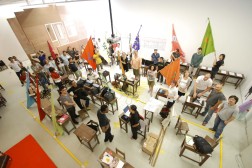
Talking, Walking and Making by Zoe Butt
This essay was written as a reflection of the writer’s participation in the Making of the New Silk Roads summit hosted by Arthub in Bangkok.
Constructive notes for a potential Stage Two
The making of a road necessitates a journey. How that journey eventuates is both a question of mental and physical strategy. Re-tracing the knowledge of our inherited and lived memories is always a process of a kind of sentimental nostalgia, perhaps somewhat more traumatic for some. Performing these memories, articulating them to a disparate audience, where language and lifestyle is so markedly at odds with each other, is a challenge. How do you share the emotion of a memory and its tale? Under what kind of cultural or political context do you sort these memories into a kind of narrative? This is the struggle of writing a history, of attempting to re-draw the lines of why, what and for whom. I felt this struggle during these 3 days in Bangkok. I sought an insight into these questions in this gathering for ‘The Making of the New Silk Roads’, particularly in reference to my own work as a curator and writer. In my practice I have consistently looked to the voice of culture as a means of engaging a physical and psychological space of an artistic community, believing that through ‘talking, walking and making’ we can catalyze remembrances of the past in a new fashion, helping motivate or rekindle an awareness of the significant role each individual possesses towards an evolving society.
Over the course of the brief three days that we all shared I was most allured by the use (or lack of) the human body in the delivery of this ‘performative symposium’. I came to appreciate the way the participants worked in mediums relevant to the contexts in which they work. Such as the way the voices amplified the bodies of Lina Saneh (Lebanon) and Samah Hijawi (Jordan) in the recounting of their tales revealing the power of the written word and its oration. The use of speech in this way lay in stark contrast to the performances by artists from South East Asia, where the power lay in the human gesture, in the use of color and duration of time (Le Huy Hoang, Vietnam; Jompet, Indonesia; Gary Pastrana, The Philippines).
Harnessing the power of word and image through the human body was no doubt perhaps one of the desired aims in requesting this conference be ‘performed’. While I am open to the model of dialogue (conference, symposia, lecture) being challenged, and while there were several ‘presentations’ that inspired my consideration of a new kind of ‘silk road’ (such as through the work of Kyong Park (Korea), Howard Chan (Hong Kong) and Stefan Rusu (Moldovia)), I found overall that the space in which we were sitting was not allowing an openness that could have assisted in breaking down the various differences we all felt towards one another. This led me to think that the kind of space in which a performed articulation of a cultural engagement occurs is crucial to gauging the success of transmission of information, the dynamism of that space deserving a theatric. When I speak of ‘space’, I refer to a shared zone of time that understands that the visual world in front of them holds a series of aesthetic codes that operate with a kind of pre-determined meaning. Sitting as we were inside a white gallery space-cum-classroom throws two hierarchical systems of learning into a single experience. While the idea of designing the interior of the gallery into a kind of educational zone is an interesting questioning of the role of the gallery system in the art of ‘learning’, I have to admit that after a full day of talk, the discussion felt not the centre of the ‘display’, but rather our own bodies were the objects on view (to this end in my mind what were the most impressive ‘presentations’ were those that left an image in your mind as opposed to the concept of a speech).
To this end I think the element of the theatric could have been better considered over the course of the three days. This drama could have been realized in presentations held in relation to a designated and highly coded structure (eg. a church, an opera theatre, a bar). While sitting in BUG, my bottom going numb from sitting on my hard wooden little chair at my little wooden desk, I found myself re-visiting the age-old debate of theory versus practice wondering what the role of dialogue can be in this kind of forum where practice has been urged into some kind of performative realm, despite the fact that those who are gatherers and recorders (curators, writers, arts workers) are perhaps not instinctively attuned to the sensitivities of their knowledge being ‘performed’. I guess what I found myself asking over the course of these three days was, ‘What is our intended goal in this rotary wheel of presentations’? What is the praxis of negotiation when new borders are desired and re-drawn amidst multiple zones of cultural difference, how is this articulation produced and why? It is this nature of production that intrigues me. Bhabha states ‘Terms of cultural engagement, whether antagonistic or affiliative, are produced performatively. The representation of difference must not be hastily read as the reflection of pre-given ethnic or cultural traits set in the fixed tablet of tradition. The social articulation of difference, from the minority perspective, is a complex, on-going negotiation that seeks to authorize cultural hybridities that emerge in moments of historical transformation”. What is this historical transformation we are seeking in the “Making of a New Silk Road”? What are the desired outcomes from such a re-drawing of cultural relationships? How can we tease out the idea of ‘performative’ so that the terms of our cultural engagement are given more space to breathe? It was unfortunate that such questions were not given air during the three-day meet. Yes, the onus was placed on the participants to make what we wanted of the time and content; however, a little prompting and provoking from the facilitators would have been useful in making the participants more constructive with their ignorance of each others’ work.
In thinking through the possibility of a ‘new silk road’, in thinking further on the stories and contexts that were shared between us, I can see how much potential there is for this ‘region’ to begin its own network of artistic support and exchange (as opposed to adopting a structure modeled on Western systems of art and economy). For me, it would be interesting and much more beneficial if this project was given broader preface by examining the historical occurrence of the Silk Road. My limited knowledge (which is now in strong desire of further study into issues of Asia Minor trade; the rise of cosmopolitanism; the discussion between world leaders at the time of the collapse of the colonial empire, such as Jawaharlal Nehru) tells me that the naming of the ‘Silk Road’ came as a term in retrospect. It was a loose set of pathways that, growing over time with ever increasing cultural and economic networks, eventuating as a pipe-line of power and influence in the region, up until the expansion of the European Empire after which this never formalized group of trading alliances on this ‘Silk Road’ found themselves powerless to continue operations. The ingenuity of the initial Silk Road began as a result of the myriad of goods and services that were available at this geographical juncture. What kind of ‘goods and services’ are we holding in the making of a ‘New Silk Road’? Perhaps we should be wary of the tendency to formalize a relationship before we even know the configuration of the knowledge between us?
It strikes me as timely that the thought of considering a ‘New Silk Road’ should be occurring now in the wake of an international financial crisis that has illustrated the flaws within the capitalist system of financial gain as dictated by the West. This collapse of confidence in the structures of such an economy has revealed the strength of the Asian market, with an increasing amount of wealth seeking relocation in the Middle East. The movement of wealth and power has caused a movement in ideas, opening up the potential for new alliances and ways of making. What I would like to see with this project (in consideration of a continuing dialogue towards a possible second chapter) is to identify ways in which our respective enterprises and obsessions are useful, interested and similar. Perhaps we should focus on questioning ideas of trade in relation to the movement of information, perhaps considering a new kind of knowledge production and transference. This Bangkok gathering brought together not only artists as art makers, but also as pioneers of critical ‘space’ – this ‘space’ being at once physical and discursive. As someone who has been working, for the last 3 years, in an artistic environment with great potential (China and Vietnam), but little critical and comparative analysis, I would be very keen to see how we can share historical fact and interpretation of the shared and influential history between us so that our own borders of nationhood, state, spirituality and society (amongst others) is prompted towards a re-determination of what defines this new ‘Silk Road’.
Zoe Butt
Curator and Director (Programs and Development)
San Art, Ho Chi Minh City, VIetnam

